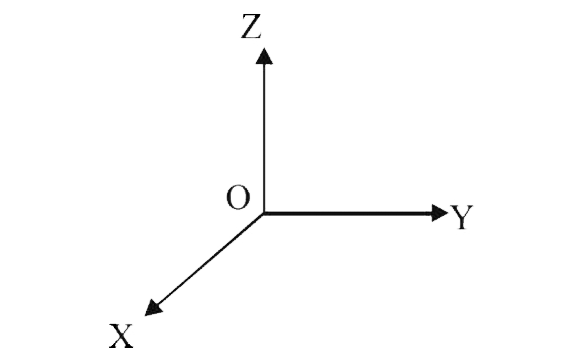Statement-I : Magnitude of torque of a force about a given point does not depend upon the location of the origin of the co-ordinate system.
Statement II: Moment of couple is different for different points in its plane
Statement-I is True, Statement-II is True and Statement-II is a correct explanation for Statement-I
-I is True, Statement-II is True and Statement-II is NOT a correct explanation for Statement-I.
Statement-I is True, Statement-II is False.
Statement-I is False, Statement-II is True
The correct Answer is:C
To solve the problem, we need to analyze both statements provided:
Statement I: The magnitude of torque of a force about a given point does not depend upon the location of the origin of the coordinate system.
Statement II: The moment of a couple is different for different points in its plane.
Step 1: Understanding Torque
- Torque (τ) is defined as the cross product of the position vector (R) from the point of rotation to the point of application of the force (F).
- The formula for torque is given by:
τ=R×F
Step 2: Analyzing Statement I
- Let’s consider a point O and a point P where the force F is applied.
- The position vector R from point O to point P is denoted as R=r^r.
- The magnitude of the torque can be expressed as:
|τ|=|R||F|sin(θ)
where θ is the angle between R and F.
Step 3: Conclusion for Statement I
- The torque depends on the relative position of the force and the point about which it is calculated, not on the choice of the origin of the coordinate system.
- Therefore, Statement I is true.
Step 4: Analyzing Statement II
- A couple consists of two equal and opposite forces acting on an object, separated by a distance d.
- The torque due to a couple is given by:
τ=F⋅d
where F is the magnitude of one of the forces and d is the perpendicular distance between the lines of action of the forces.
Step 5: Conclusion for Statement II
- The torque due to a couple is constant regardless of the point about which it is calculated. It does not change with the choice of point in the plane of the couple.
- Therefore, Statement II is false.
Final Conclusion:
- Statement I is true: The magnitude of torque does not depend on the location of the origin.
- Statement II is false: The moment of a couple is the same for all points in its plane.
- Torque (τ) is defined as the cross product of the position vector (R) from the point of rotation to the point of application of the force (F).
- The formula for torque is given by:
τ=R×F
- Let’s consider a point O and a point P where the force F is applied.
- The position vector R from point O to point P is denoted as R=r^r.
- The magnitude of the torque can be expressed as:
|τ|=|R||F|sin(θ)
where θ is the angle between R and F.
- The torque depends on the relative position of the force and the point about which it is calculated, not on the choice of the origin of the coordinate system.
- Therefore, Statement I is true.
- A couple consists of two equal and opposite forces acting on an object, separated by a distance d.
- The torque due to a couple is given by:
τ=F⋅d
where F is the magnitude of one of the forces and d is the perpendicular distance between the lines of action of the forces.
- The torque due to a couple is constant regardless of the point about which it is calculated. It does not change with the choice of point in the plane of the couple.
- Therefore, Statement II is false.
- Statement I is true: The magnitude of torque does not depend on the location of the origin.
- Statement II is false: The moment of a couple is the same for all points in its plane.
Similar Questions
Show that moment of a couples does not depend on the point about which you take the moments.
View SolutionFour particle, each of mass m, are placed at corners of a square of side a in the x-y plane. If the origin of the co-ordinate system is taken at the point fo intersection of the diagonals of the square, the co-ordinates of the centre of mass of the system are:
View Solution
Knowledge Check
A force of −F,ˆk acts on O, the origin of the coordinate system. The torque about the point (1,-1) is
 AF(ˆi−ˆj)B−F(ˆi+ˆj)CF(ˆi+ˆj)D−F(ˆi−ˆj)
AF(ˆi−ˆj)B−F(ˆi+ˆj)CF(ˆi+ˆj)D−F(ˆi−ˆj)A force of −F,ˆk acts on O, the origin of the coordinate system. The torque about the point (1,-1) is
 AF(ˆi−ˆj)B−F(ˆi+ˆj)CF(ˆi+ˆj)D−F(ˆi−ˆj)
AF(ˆi−ˆj)B−F(ˆi+ˆj)CF(ˆi+ˆj)D−F(ˆi−ˆj)A force of −Fˆk on O, the origin of the coordinate system. The torque about the point (1,−1) is.
 .AF(ˆi−ˆj)B−F(ˆi+ˆj)CF(ˆi+ˆj)D−F(ˆi−ˆj)
.AF(ˆi−ˆj)B−F(ˆi+ˆj)CF(ˆi+ˆj)D−F(ˆi−ˆj)
A force of −Fˆk actgs on O, the origin of the coodinate system. The torque about the point (1,-1) is

View SolutionA force Fˆk acts on O, the origin of the coordinate system. The torque of this force about the point is: (1,−1) is
View SolutionA force of −4FˆK acts O, the origin of the coordinate system. The torque about the point (1,−1) is
View SolutionStatement I : Work done in moving a body over a smooth inclined plane does not depend upon slope of inclined plane, provided its height is same.
Statement II : W = mgh = mglsin
View SolutionThe torque of a force F=−6ˆi acting at a point r=4ˆj about origin will be
View Solution

